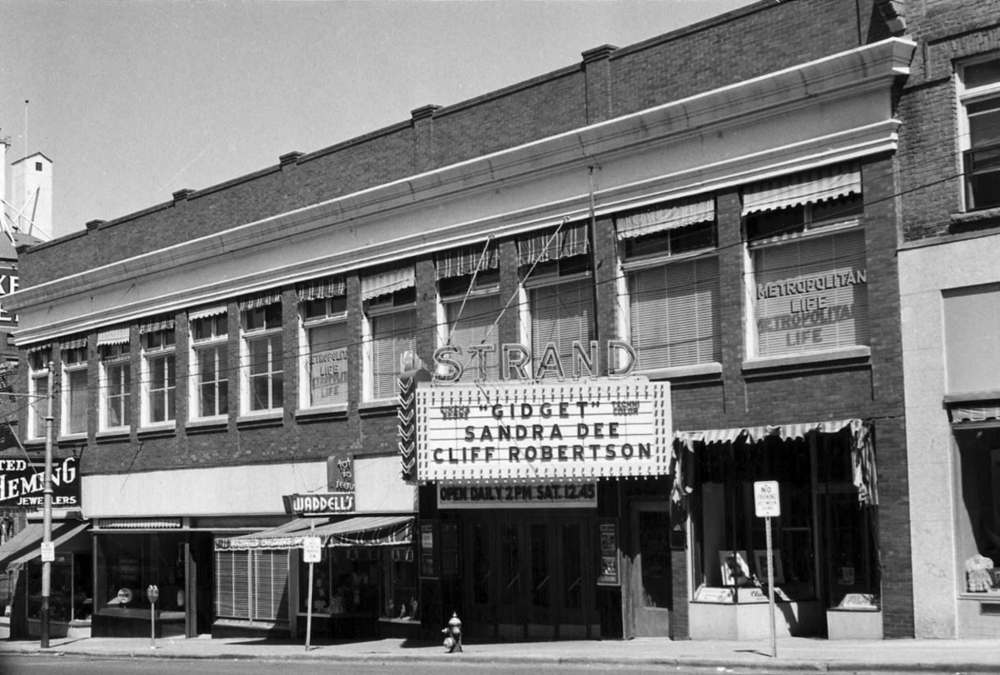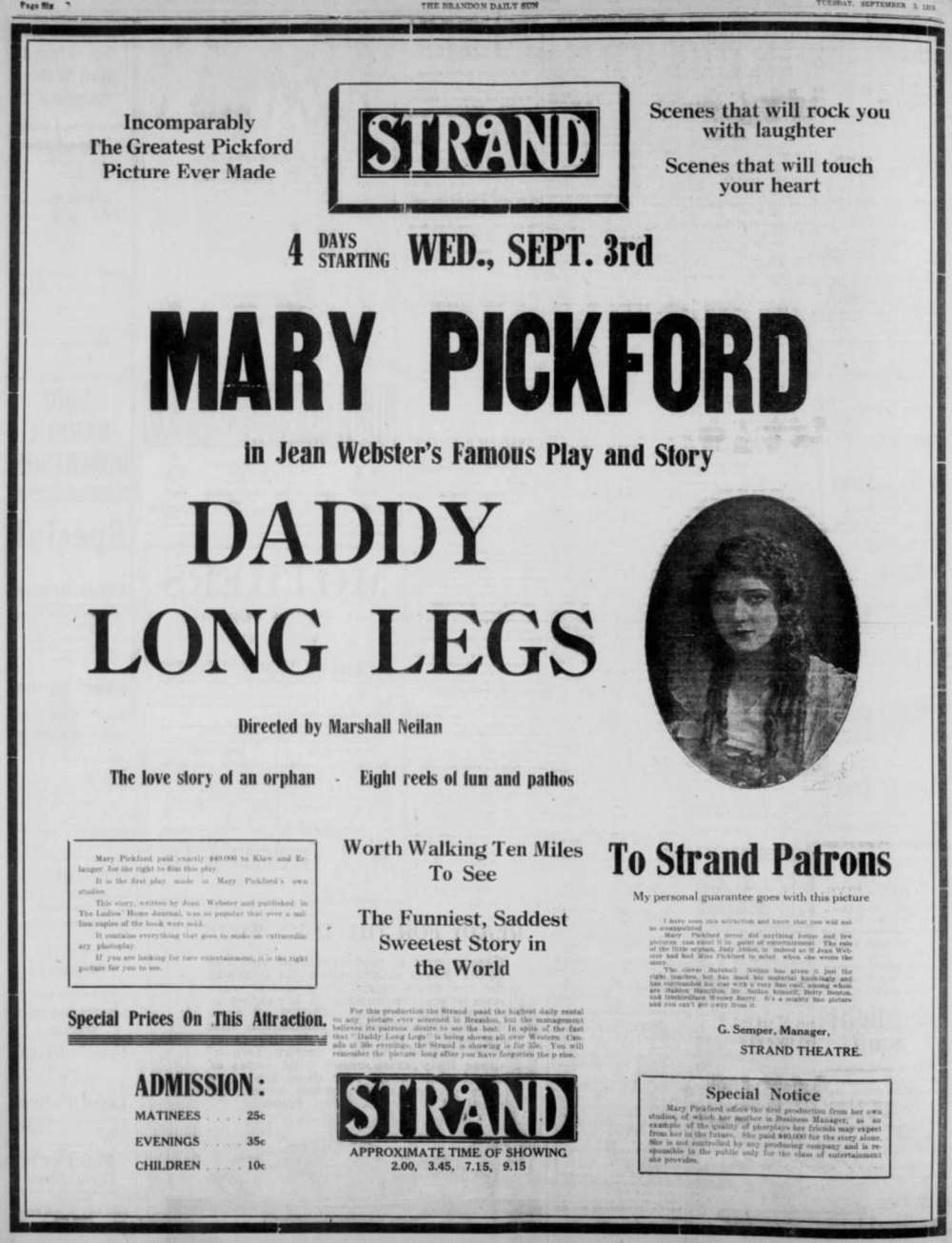Taking a Strand
Historic former theatre will live on -- in some form -- after being acquired by Brandon University
Advertisement
Read this article for free:
or
Already have an account? Log in here »
To continue reading, please subscribe:
Monthly Digital Subscription
$1 per week for 24 weeks*
- Enjoy unlimited reading on winnipegfreepress.com
- Read the E-Edition, our digital replica newspaper
- Access News Break, our award-winning app
- Play interactive puzzles
*Billed as $4.00 plus GST every four weeks. After 24 weeks, price increases to the regular rate of $19.00 plus GST every four weeks. Offer available to new and qualified returning subscribers only. Cancel any time.
Monthly Digital Subscription
$4.75/week*
- Enjoy unlimited reading on winnipegfreepress.com
- Read the E-Edition, our digital replica newspaper
- Access News Break, our award-winning app
- Play interactive puzzles
*Billed as $19 plus GST every four weeks. Cancel any time.
To continue reading, please subscribe:
Add Winnipeg Free Press access to your Brandon Sun subscription for only
$1 for the first 4 weeks*
*$1 will be added to your next bill. After your 4 weeks access is complete your rate will increase by $0.00 a X percent off the regular rate.
Read unlimited articles for free today:
or
Already have an account? Log in here »
Hey there, time traveller!
This article was published 08/01/2017 (3167 days ago), so information in it may no longer be current.
It may have come three days late, but Brandon’s historic Strand Theatre received a very welcome 100th-birthday present.
Late last year, Brandon University purchased the last remaining theatre building in the city’s downtown for $1 from its owners, Landmark Cinemas.
The university hasn’t decided what it will do with the building. Its vice-president academic and provost, Dr. Steve Robinson, said in a statement Dec. 12: “Brandon University is moving to expand our role in community-based research as well as co-op and experiential education. A presence downtown can allow us to strengthen these links, forge new ones and provide a full spectrum of study and research opportunities.”

Brandon University Students’ Union president Nick Brown said, “We already have some ideas, such as student residences and student family housing, which would be ideal given the location right across from Princess Park and recreational facilities.”
This could end up being a happy ending for what has been a sad decade for the 10th Street institution.
Since closing in January 2005, the not-for-profit Brandon Folk, Music, and Art Society struggled, and failed, to convert it into a community arts space and performance venue. In 2011, the neighbouring Brown Block collapsed and, because of a shared wall, almost took the Strand down with it.
● ● ●
It was a much different story a century ago, when hundreds lined up to attend the Strand’s opening night Nov. 27, 1916. The frontman for the venture was George Semper. British-born and raised, he settled in Winnipeg and in March 1912 founded the Canadian Amusement Company, a “pool room and picture theatre business,” with $50,000 in capital.
Semper’s dream was to operate a western Canadian-wide chain of cinemas. His first — and, it appears, only — step toward building that empire came four months later when his company purchased Brandon’s Bijou Theatre on Ninth Avenue. Semper moved his family to the Wheat City to be its manager.
The Bijou was a small house with around 300 seats. Its mainstay was moving pictures, though Semper placed ads in Winnipeg looking for musicians and comedians to perform acts in between film reels.

In April 1916, Semper’s Canadian Amusement Company and business partner H. Sidney Watts, a Brandon real estate and insurance broker, announced they were seeking a location for a new, larger theatre. The next month, they chose a site in the 100 block of 10th Avenue, part of a large parcel of land belonging to Joseph Hughes, the lumber merchant and former Brandon mayor.
Construction began in June 1916 on what was expected to be an $80,000 development that would not only house Brandon’s largest theatre at just over 600 seats but also four retail spaces on the main floor and offices upstairs.
The Strand’s neat but rather plain exterior was mirrored in its interior, which was geared toward comfort rather than grandeur. Advertisements stressed the 36 inches of legroom, indirect amber lighting and an oversized ventilation system. There were no raised boxes, but there were six partitioned booths at the back of the house outfitted with wicker chairs. Built as a cinema, the stage was large enough to host vaudeville acts and concerts and was connected to a series of small dressing rooms.
The opening of the Strand Nov. 27, 1916 was a grand affair. Owner/manager Semper and Mayor Henry Cater presided over the festivities, and the 16-piece 181st Regiment band performed for the audience.
The Strand was initially affiliated with the Famous Players-Lasky Corp. The first movie shown was Lasky’s The Honourable Friend, starring Japanese actors Sessue Hayakawa and Tsuri Aski. This was followed by a Gaumont Graphic newsreel and comedy short.
The Strand’s opening came during the First World War, and many young men from the region were away fighting. Some had lost their lives. Mayor Cater referenced this in his opening address, noting, “A merry heart and a hearty laugh go a long way.”
This point was not lost on Semper, himself a veteran and former vice-president of the Imperial South African Veterans Association in Manitoba. He saw the theatre did its part for the war effort.
In its first week of operation, for example, the Strand donated the receipts from all of its matinees to a trio of wartime relief charities. In its second week, the Strand showed the 1916 British documentary propaganda film Battle of the Somme — with its grim, close-up footage of trench warfare and death — in a loop for three days straight.

The Strand was the grandest of Brandon’s five theatres when it opened, but that supremacy didn’t last long. In August 1917, Allen Theatre Enterprises of Toronto opened the similar-sized, and likely more glamorous, Allen Theatre at 113 Eighth Street. The two houses fought it out for cinematic bragging rights for the next 45 years.
In March 1923, Allen Theatre Enterprises went bankrupt, and its fierce rival, Famous Players, picked up its best properties at cheap prices. This included Brandon’s Allen Theatre, which was renamed the Capitol.
Later that year, the Allens began piecing together an upstart western Canadian chain and purchased the Strand in November 1923. Semper stayed on as manager for more than a year before leaving to start a new venture — a silver fox farm on Victoria Avenue — before eventually retiring to British Columbia.
Famous Players soon absorbed the new Allen venture, and by 1926 Brandon’s two largest cinemas were owned by the same chain.
In November 1929, Famous Players announced the Strand would become Brandon’s first “talking picture” theatre. They invested more than $30,000 in a seven-week renovation project that required it to close for most of January 1930.
Aside from the new projectors and sound system, the theatre itself got an overhaul. The main-floor retail space was scaled back to allow for a new central entrance. The box office was moved into an expanded lobby, which meant patrons could now line up inside to wait for the house to open. A new, backlit marquee illuminated 10th Street.
The former “comfortable” interior gave way to touches of elegance with silk panels on the walls, 800 red leather seats, chandelier lighting and plush, red carpeting throughout.
Again, it was Cater, now on his third stint as Brandon’s mayor, who cut the ribbon to reopen the Strand on Feb. 4, 1930.

The first talking picture shown was the unfortunate choice of Why Bring That Up? featuring “The Two Black Crows,” Charles Mack and George Moran, a blackface comedy and singing duo. It was followed by a talking comedy short by Charley Chase and a Paramount newsreel. The Brandon Sun noted, “the talking sequences went over well.”
Decades later, the Strand’s longest-serving manager was responsible for another Brandon first: Sunday entertainment.
John Pungente managed the theatre from 1945 until 1977, after which he became manager of the Green Acres Drive-Inn and a relief manager at the Strand until his retirement in 1990 at the age of 78. He lobbied city council in summer 1964 to allow movies to be shown on Sundays and persuaded them to include the matter as a referendum question in October’s civic election.
The matter was separated into three ballot questions about Sunday entertainment, all of which passed easily. Soon after, Brandonites could attend sporting events (except wrestling), watch movies and bowl after 1:30 p.m. Sundays.
● ● ●
In cities across North America, single-screen downtown theatres were on the wane in the 1960s and 1970s. Unlike larger cities, though, there were no new suburban cinemas opening in Brandon to replace them. The Strand became Brandon’s go-to theatre by attrition.
The Capitol, its Famous Players sister, was closed in 1962 and demolished soon after, which left the 300-seat Oak Theatre as the Strand’s only competition. The Oak closed in 1974 but reopened from 1976 to 1998 as the Towne Cinema.

Famous Players sold off the Strand in 1995, and it was eventually purchased by Landmark Cinemas of Calgary.
It was Landmark that built Brandon’s first suburban multiplex cinema, the four-screen Capitol, at the Shoppers Mall in 1998. In 2004, they announced the addition of five more screens that, when completed, would mean the closure of their downtown theatre.
The Strand went dark in January 2005 after a run of Elektra, a superhero film starring Jennifer Garner.
Though it is unlikely a film will ever be shown there again, the reuse of the building will keep alive a faint memory of Brandon’s once-vibrant downtown theatre history.
Christian writes about Manitoba history on his blog, West End Dumplings.

Our newsroom depends on a growing audience of readers to power our journalism. If you are not a paid reader, please consider becoming a subscriber.
Our newsroom depends on its audience of readers to power our journalism. Thank you for your support.
History
Updated on Sunday, January 8, 2017 10:18 PM CST: Corrects reference to 10th Street.
Updated on Monday, January 9, 2017 9:09 AM CST: Corrects typo, adds link

